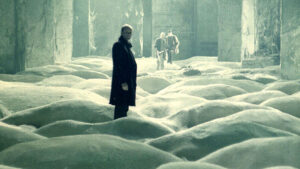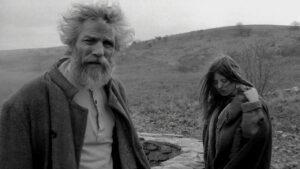Table of Contents
Introduction: Exploring the Depths of Arrival
In the realm of science fiction, few films resonate as deeply as Arrival, a profound exploration of language, time, and human connection. This cinematic masterpiece, directed by Denis Villeneuve, invites viewers not only to engage with its narrative but also to reflect on the intricate psychology and philosophy it presents.
Arrival Explained is more than just a breakdown of the plot; it’s an invitation to delve into the layers of meaning behind the aliens’ enigmatic language and the impact of communication on human perception and relationships. As we explore the film’s psychological and philosophical dimensions, we unravel the complexities that challenge our understanding of reality and choice.
Join us on this journey as we dissect the elements that make Arrival a compelling study of existence, ultimately leading us to a richer understanding of what it means to communicate and connect.

Psychology of Language and Communication in Arrival
In Arrival, the intricate relationship between language and thought becomes a focal point. The film brilliantly illustrates how communication shapes our perception of reality and influences our emotional experiences. Through the lens of psychology, we gain insight into the profound implications that arise when we encounter an entirely new form of communication.
The Sapir-Whorf Hypothesis
One of the central themes explored in the film is the Sapir-Whorf Hypothesis, which posits that the structure of a language affects its speakers’ cognition and worldview. When Dr. Louise Banks, portrayed by Amy Adams, learns the alien language of the Heptapods, she begins to perceive time in a nonlinear fashion. This shift not only alters her understanding of reality but also influences her emotional attachments and decision-making processes.
The ability to perceive time differently raises profound questions about how language shapes thought and experience. In essence, as Louise learns to think like the Heptapods, she comes to understand the interconnectedness of past, present, and future. This exploration of language is a stark reminder of the power words hold in shaping our mental landscapes and experiences.
Communication as Connection
The film also highlights the significance of communication in fostering connections between individuals. For Louise, learning the alien language transcends mere verbal exchange; it becomes a means of building empathy and understanding. In her interactions with the Heptapods, she discovers a new approach to communication that prioritizes comprehension over mere words.
The emotional weight of this connection is poignantly felt in her relationships with fellow humans, particularly with her daughter. The film raises important questions about how language can bridge divides and foster deeper bonds, especially in times of uncertainty. Through the lens of psychology, we see that effective communication is not just about the words spoken, but also about the intention behind them.
The Emotional Impact of Communication
As Louise becomes more fluent in the Heptapod language, she experiences a profound emotional shift. This transformation reveals the psychological interplay between language, memory, and emotion. The non-linear perception of time allows her to access memories of her daughter’s life, both joyful and heartbreaking, in a way that profoundly affects her decisions.
The impact of communication extends beyond intellectual understanding; it also infiltrates the realm of emotions, challenging the characters’ motivations and choices. This exploration demonstrates that language is not merely a tool for exchange but a conduit for emotion, memory, and identity, illustrating the complex psychological terrain that Arrival navigates.

Philosophical Implications of Time and Free Will in Arrival
Arrival presents a thought-provoking exploration of time and free will, posing fundamental questions about how we perceive our lives and the choices we make. As the narrative unfolds, it challenges our conventional understanding of linear time and invites us to consider the implications of a non-linear perspective.
The Nature of Time
In most human experiences, time is perceived as a linear progression—a series of moments that flow from the past through the present and into the future. However, through the lens of the Heptapods’ language, Arrival introduces an alternative view of time that suggests a more cyclical and unified understanding.
As Louise Banks begins to grasp the alien language, she experiences a transformative shift that allows her to perceive moments from her life as interconnected and simultaneous. This reframing of time not only alters her cognition but also poses philosophical questions about destiny and preordained events. Are we simply participants in a predetermined narrative, or do we have the power to shape our own destinies? The film masterfully blurs the lines between fate and free will, prompting viewers to reflect on their own experiences of time and the decisions that define them.
The Illusion of Free Will
The question of free will is intricately entwined with the film’s philosophical inquiries. By showing Louise’s foreknowledge of her daughter’s tragic fate, Arrival challenges the notion of free will. If we can foresee our choices and their consequences, do we still possess the autonomy to choose differently?
As Louise confronts her knowledge of the future, the film invites us to ponder whether the weight of that knowledge empowers or paralyzes us. The philosophical discourse surrounding determinism versus free will becomes particularly poignant as we witness Louise’s emotional journey. Her acceptance of her daughter’s fate, despite knowing the heartache it will bring, raises significant questions about the value of choice itself. Is the ability to make decisions meaningful if we are already aware of the outcomes?
The Gift and Burden of Knowledge
Arrival deeply explores the implications of knowledge about time and its effect on human agency. For Louise, the act of understanding the Heptapod language comes with profound emotional ramifications. As she learns to perceive events from her life simultaneously, she gains insight into both joyous and painful moments. This duality emphasizes the burden of knowledge—understanding both the beauty and tragedy of life becomes a heavy load to carry.
Ultimately, the philosophical inquiry into time and free will in Arrival challenges us to reconsider our own relationship with temporal existence. The film deftly illustrates that our awareness of past, present, and future intertwines with our choices and their emotional impacts, reminding us that the bittersweet nature of knowledge shapes our humanity.

Ending Explained: Making Sense of the Finale
The ending of Arrival is both poignant and enigmatic, leaving viewers with a sense of ambiguity and reflection. As the narrative unfolds, it becomes clear that the film is not merely about finding answers, but rather about the journey of understanding and acceptance.
The Revelation of Time
In the final moments, it is revealed that Louise has fully grasped the Heptapod language, which allows her to perceive time non-linearly. She experiences scenes from her future interwoven with her past, a representation of how the Heptapods experience existence. This revelation leads to a powerful emotional convergence where viewers witness the depth of her relationship with her daughter, including the joy and inevitable sorrow that awaits her.
The film concludes with Louise acknowledging her daughter’s fate—even knowing the difficult path ahead of them. This choice speaks volumes about the human experience, highlighting the idea that love often involves embracing pain alongside happiness. By understanding that life’s moments are interconnected, Louise’s acceptance frames her journey as one of resilience rather than despair.
The Role of Choice
A significant aspect of the ending lies in the concept of choice. Many viewers grapple with the idea that knowing the future could lead to reluctance in making decisions. However, Arrival presents a different perspective. Louise’s acceptance of her daughter’s future reinforces the idea that knowing potential outcomes does not strip away the importance of choice; it adds depth to it.
In this light, her decision to have a child, despite knowing the heartache that awaits, becomes an empowering act of love. Each moment, whether joyful or painful, is valuable and contributes to her identity. This philosophical undercurrent raises questions about the nature of decision-making when faced with foresight—whether to embrace or recoil from likely outcomes.

Connection with the Heptapods
Throughout the film, Louise’s growing bond with the Heptapods culminates in the closing scenes, revealing their purpose for visiting Earth. They are not merely there to communicate but to impart the understanding of their language, which enables its users to experience time differently. This connection symbolizes an exchange between humanity and the mysterious beings, emphasizing empathy and shared experiences as pathways to understanding.
As the film closes, the Heptapods’ message about the cyclical nature of time and existence reinforces the interconnectedness of all beings. By bridging the gap between species, Arrival emphasizes the potential for unity and cooperation in the face of uncertainty.
Visual and Narrative Techniques in Arrival
Arrival employs a range of visual and narrative techniques that enhance its thematic depth and emotional resonance. Denis Villeneuve’s direction, combined with Roger Deakins’ cinematography, creates a striking atmosphere that immerses viewers in both the tension of first contact and the profound psychological and philosophical questions at play.
Cinematic Imagery and Symbolism
One of the most notable visual techniques in Arrival is its use of imagery to symbolize the interplay of language and perception. The design of the alien spacecraft and the Heptapods themselves is striking, serving as a visual representation of the unknown. The monochromatic tones and the stark contrast of the spacecraft against the natural landscape evoke a sense of unease and wonder.
The circular symbols of the Heptapod language reinforce the film’s themes of nonlinear time and interconnectedness. This visual motif not only represents their mode of communication but also embodies the film’s philosophical message that all moments are intertwined. By presenting a visual language that eschews the linearity of human writing, the film highlights the perceptual shift that understanding this language brings to Louise.

Nonlinear Storytelling
Narratively, Arrival adopts a nonlinear storytelling structure that mirrors the film’s exploration of time. The film intersperses scenes from the past and future, gradually revealing Louise’s experiences with her daughter alongside her interactions with the Heptapods. This technique creates a rich, emotional tapestry that emphasizes the film’s central theme of time as a fluid concept.
The initial confusion that arises from this structure invites viewers to engage actively with the narrative, piecing together the context of Louise’s revelations. As the story unfolds, the audience becomes increasingly aware of the profound connections between memory, language, and experience, culminating in an emotional climax that resonates deeply.
Sound and Silence
In addition to its visual and narrative techniques, Arrival expertly utilizes sound and silence to heighten tension and emotional impact. The film’s sound design plays a crucial role in establishing the atmosphere of uncertainty and anticipation during the alien encounters. The use of ambient noise juxtaposed with moments of silence deepens the viewer’s immersion in the story, making the experiences of both the characters and the audience feel raw and immediate.
The score, composed by Jóhann Jóhannsson, complements the film’s atmosphere beautifully, weaving in ethereal melodies that evoke a sense of wonder and melancholy. This combination of sound and visual techniques creates a holistic experience that allows the audience to feel the weight of the story on both an intellectual and emotional level.

Book Recommendations that Echo Arrival’s Themes
Arrival delves into complex themes of language, perception, time, and human connection. Here are five thought-provoking books that resonate with these themes, offering deeper insights into the ideas explored in the film.
“The Language Instinct: How the Mind Creates Language” by Steven Pinker
In this groundbreaking work, cognitive scientist Steven Pinker explores the innate human capacity for language. He discusses how language shapes our thoughts and perceptions, paralleling the philosophical inquiries raised in Arrival. Pinker’s insights into the nature of communication provide a meaningful context for understanding the film’s exploration of linguistic relativity.
Buy “The Language Instinct” here
“SAPIENS: A Brief History of Humankind” by Yuval Noah Harari
Harari’s SAPIENS offers a sweeping overview of human history, examining how shared belief systems and narratives have shaped our societies. The book’s exploration of how language and communication have influenced human development mirrors the themes in Arrival, making it a compelling read for those interested in the power of words and the human experience.
Buy “SAPIENS” here
“Time and Narrative” by Paul Ricœur
This philosophical work delves into the relationship between time and narrative structure. Ricœur’s exploration of how stories shape our understanding of time aligns closely with the themes of nonlinear time presented in Arrival. His insights into narrative identity and temporality can deepen your appreciation of the film’s complex storytelling approach.
Buy “Time and Narrative” here
“The Dispossessed” by Ursula K. Le Guin
In this seminal science fiction novel, Le Guin explores themes of language, communication, and societal structures through the lens of two contrasting worlds. The book’s examination of different modes of understanding and existence resonates with the linguistic and philosophical explorations in Arrival, making it a must-read for fans of the genre.
Buy “The Dispossessed” here
“Einstein’s Dreams” by Alan Lightman
Lightman’s novel presents a series of vignettes that imagine different conceptions of time through the eyes of Albert Einstein. Each dream explores unique interpretations of time and existence, paralleling the film’s central theme of nonlinear time perception. This imaginative work will resonate with anyone intrigued by the philosophical implications of time.
Buy “Einstein’s Dreams” here
Conclusion: Reflecting on the Impact of Arrival
In conclusion, Arrival serves as a profound exploration of the intricate relationship between language, time, and human connection. As we have examined through various lenses of psychology and philosophy, the film challenges our perception of reality and invites us to reconsider the nature of communication and choice.
By blending visual storytelling with deep thematic elements, Arrival not only captivates its audience but also provokes meaningful reflection on the complexities of existence. The insights gained from this cinematic experience resonate far beyond the screen, encouraging viewers to engage with the world in more empathetic and nuanced ways.
Ultimately, Arrival Explained reveals that our understanding of language and time significantly influences our experiences and relationships, urging us to embrace both the joy and the sorrow inherent in our choices.
Take a look at all our in-depth reviews here.




